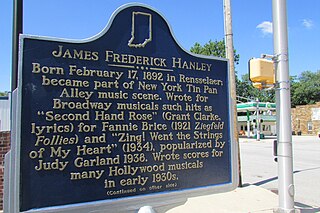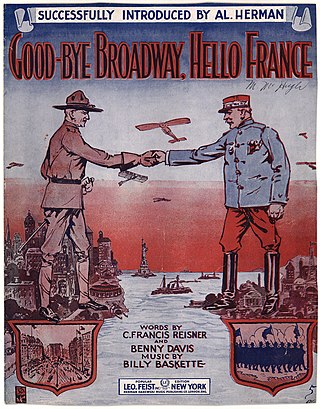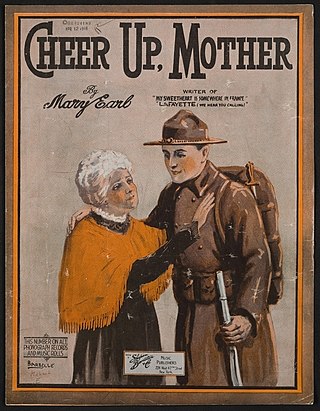
Alfred Bryan was a Canadian lyricist.

Gustav Gerson Kahn was an American lyricist who contributed a number of songs to the Great American Songbook, including "Pretty Baby", "Ain't We Got Fun?", "Carolina in the Morning", "Toot, Toot, Tootsie ", "My Buddy" "I'll See You in My Dreams", "It Had to Be You", "Yes Sir, That's My Baby", "Love Me or Leave Me", "Makin' Whoopee", "My Baby Just Cares for Me", "I'm Through with Love", "Dream a Little Dream of Me" and "You Stepped Out of a Dream".

William Denight Cobb was an American lyricist and composer. He and a partner, Ren Shields, produced several popular musicals and musical comedies in the early 20th century. Cobb also had a long-run collaboration with Gus Edwards.
Ballard MacDonald was an American lyricist, who was one of the writers of Tin Pan Alley.

James Frederick Hanley was an American songwriter and author.

Joseph Edgar Howard was an American Broadway composer, lyricist, librettist, and performer. A famed member of Tin Pan Alley along with wife and composer Ida Emerson as part of the song-writing team of Howard and Emerson, his hits included "Hello! Ma Baby" and Broadway musicals like "I Wonder Who's Kissing Her Now?".

"Au Revoir, but not Good Bye: Soldier Boy" is a 1917 song composed by Albert von Tilzer, with lyrics written by Lew Brown.

Good-Bye Broadway, Hello France is a 1917 song composed by Billy Baskette, with lyrics written by C. Francis Reisner and Benny Davis. The song was published by Leo Feist, Inc.

"Goodbye Alexander, Goodbye Honey Boy" is a World War I song describing an African American soldier going off to war and his girlfriend's reaction in his military service. The song is credited to Henry Creamer and Turner Layton, the writers of Sweet Emalina, My Gal and After You've Gone.

"Cheer Up, Mother" is a World War I era song released in 1918. Mary Earl composed the music and wrote the lyrics. Shapiro, Bernstein & Co. of New York, New York published the song. Artist Albert Wilfred Barbelle designed the sheet music cover. It features a mother saying good-bye to her soldier son. It was written for both voice and piano.

"My Sweetheart Is Somewhere in France" is a World War I era song first released in 1917. Mary Earl composed the music and wrote the lyrics. Shapiro, Bernstein & Co. Inc. of New York City published the song. Elizabeth Spencer performed a version of the song that was released by the Victor record label.

"Send Me a Line When I'm Across the Ocean" is a World War I era song first released in 1917. Irving Crocker wrote the lyrics. George L. Cobb composed the music. It was written for both voice and piano. Walter Jacobs of Boston, Massachusetts published the song. The cover was designed by Rose Starmer. On the cover is a watercolor painting of an ocean with ships in the background. In the foreground is an envelope addressed: "Private Good-boy; Rainbow Division; Somewhere in France."

"When the Lilies Bloom in France Again" is a World War I era song released in 1918. Robert Levenson wrote the lyrics. George L. Cobb composed the music. It was published by Walter Jacobs of New York City and Boston, Massachusetts. There are two versions of the sheet music cover. One was designed by Rose Starmer. The cover is described as an "artistic words only cover." Another cover is a painting of a garden, with lilies in the foreground. The song was written for both voice and piano.

"So Long, Mother" is a World War I era song released in 1917. Raymond B. Egan and Gus Kahn wrote the lyrics. Egbert Van Alstyne composed the music. The song was published by Jerome H. Remick & Co. of Detroit, Michigan. On the cover is a soldier and mother in an embrace. To the left is an inset photo of singer Al Jolson. It was written for both voice and piano.

"I May Be Gone for a Long, Long Time" is a World War I era song released in 1917. It was featured in the 1917 stage production of Raymond Hitchcock and E. Ray Goetz's Hitchy-Koo. Lew Brown wrote the lyrics. Albert Von Tilzer composed the music. The song was published by Broadway Music Corp. of New York, New York. André De Takacs designed the sheet music cover. It features Grace La Rue's image blended into the clouds of an ocean scene. The song was written for both voice and piano.

"Tom, Dick and Harry and Jack " is a World War I era song released in 1917. Howard Johnson wrote the lyrics. Milton Ager composed the music. The song was published by Leo Feist, Inc. of New York City. Artist Henry Hutt designed the sheet music cover. It features four men in different service uniforms with an inset photo of either Jack Connors, Jr. or Bailey and Cowan. The inset photo varies by edition. It was written for both voice and piano.

When the Clouds of War Roll By is a World War I song composed by Earl Haubrich with lyrics by Nat Binns. It was published in 1917 by Ted Browne Music Co. in Chicago, Illinois.
"Good-bye France " is a World War I song written by Irving Berlin. It was published in 1918 by Waterson, Berlin & Snyder, Inc., in New York City. The sheet music cover, illustrated by Albert Wilfred Barbelle, features French and American soldiers shaking hands with the Statue of Liberty in the background.

"I'm Hitting the Trail to Normandy: So Kiss Me Goodbye" is a World War I song written and composed by Charles A. Snyder and Oscar Doctor. The song was published in 1917 by Snyder Music Co. in New York City. The sheet music cover, illustrated by E. H. Pfeiffer, depicts a soldier kissing a woman good-bye with an inset photo of Paul Elwood.

"The Russians Were Rushin', the Yanks Started Yankin'" is a World War I song written by Carey Morgan and composed by Charles R. McCarron. The song was first published in 1918 by Broadway Music Corporation in New York City. The sheet music cover depicts an elderly man smoking a pipe with silhouetted soldiers across the top and bottom.


















